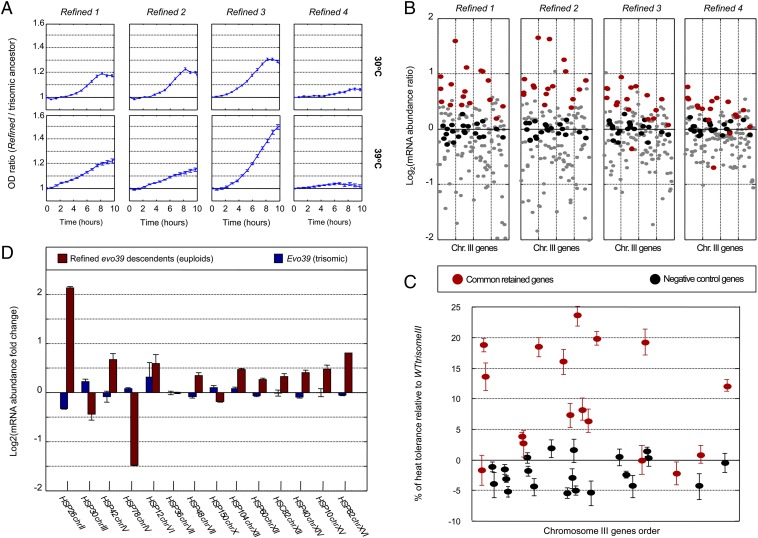Fig. 4.
The aneuploidy-based adaptation was evolutionarily eliminated and replaced by more economical solutions based on refined gene expression adaptations. (A) Descendants of chromosome III trisomic ancestors that were further evolved under heat and lost the trisomy (Refined 1–4) show improved growth under heat, yet with less cost compared with their trisomic ancestors. Each subgraph shows the OD ratios of a refined descendant over its trisomic ancestor measured during continuous growth at 30 °C (Upper) and at 39 °C (Lower). (B) Despite elimination of the trisomy in Refined 1–4, a group of genes from chromosome III retained high expression levels. Dots represent log2 ratios of mRNA abundance of chromosome III genes over a diploid wild type. Genes that retain high expression (in at least three of the four refined evolutions; for details see SI Text) are marked in red, and from the majority of genes that went back to wild-type–like expression (gray dots) a control group was selected and marked in black (used in C). These retained genes were also up-regulated in H2 and H4, which also eliminated the trisomy (χ2 P values 4 × 10−5 and 3 × 10−2). (C) The group of genes that retain high expression levels, after the elimination of the trisomy, confers increased heat tolerance when introduced into wild type. Each of the highly expressed genes (red) and the negative control genes (black) was inserted into the diploid wild type, on a centromeric plasmid, and heat-shock tolerance was compared with the heat tolerance of WTtrisomeIII (t test P value < 5 × 10−7; Materials and Methods). (D) The refined solution replacing the trisomy is characterized by changes in expression levels of most HSP genes. Log2 expression ratios over wild type are shown for all HSPs, for trisomic evo39 (blue) and its descendants that eliminated the trisomy (red). Data are presented as mean and SEM.

